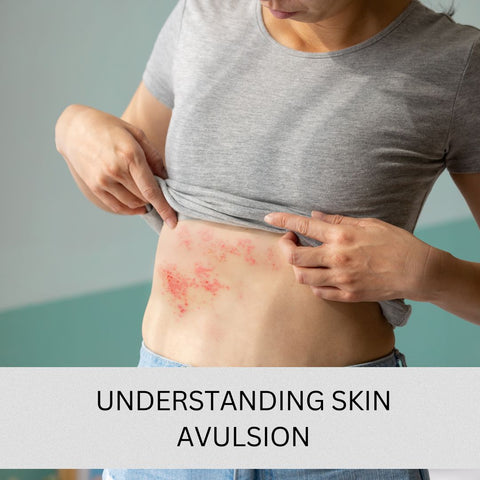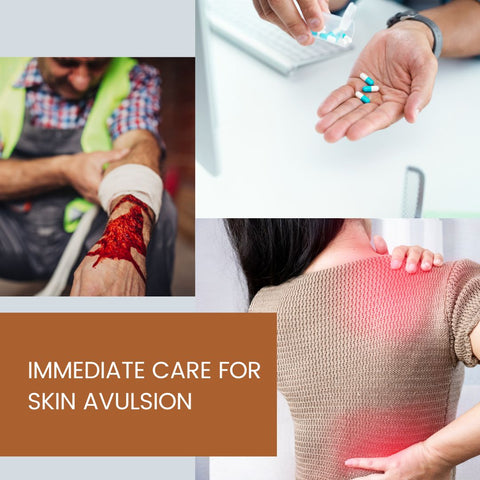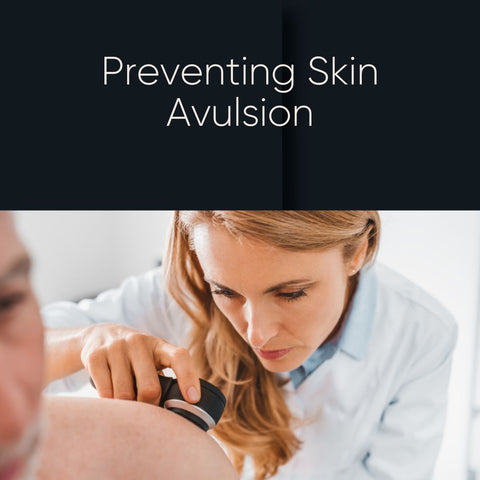A skin avulsion is a serious injury in which the skin is violently separated from the underlying tissue, revealing muscles, tendons, or bones. We will talk about a few of the skin avulsion conditions that can lead to this kind of injury in this blog.
Understanding Skin Avulsion

A skin avulsion is a devastating injury in which the skin is violently pulled away from the underlying tissue. This sort of injury can be mild or severe, depending on the level of tissue damage and the size of the avulsed area. Skin avulsions can occur in a variety of settings, including accidents, sports injuries, animal bites, and surgical operations. A skin avulsion exposes the underlying structures, such as muscles, tendons, or bones, resulting in considerable discomfort, bleeding, and infection. Immediate medical attention is required to determine the severity of the damage and administer appropriate therapy.
What Is Skin Avulsion?
Skin avulsion is a severe injury in which the skin is forcibly separated from the underlying tissue. This causes a portion of the skin to detach from the body, exposing underlying structures like muscles, tendons, or bones. Skin avulsions can range in severity from partial avulsions, where only a portion of the skin is torn away, to complete avulsions, in which the entire skin is severed from the body. Skin avulsions can result from a variety of traumatic incidents, including:
-
Car accidents, falls, and industrial mishaps all involve skin being caught and torn away by machinery or sharp objects.
-
High-impact sports activities that include collisions or falls can result in skin avulsions.
-
Severe animal bites can tear away skin, causing avulsion injuries.
-
Skin avulsions can occasionally result from intense friction against rough surfaces or objects.
-
In rare cases, surgical errors or complications can cause unintended skin avulsions.
Common Causes of Skin Avulsion
Skin avulsion, a severe type of injury in which the skin is violently separated from the underlying tissue, can occur for a variety of reasons. Common causes include traumatic accidents, sports injuries, animal attacks, machinery accidents, abrasions, surgical operations, falls, and traumatic injuries. Preventing skin avulsion injuries requires taking safety precautions in a variety of settings, such as wearing appropriate protective gear during sports activities, exercising caution when operating machinery, keeping pets under control to avoid bites, and maintaining a safe environment to avoid falls and accidents.
Identifying Skin Avulsion Severity
Identifying the severity of a skin avulsion is critical for determining the best treatment and assessing the potential risks of the injury. Here are some important factors to consider when determining the severity of a skin avulsion.
-
A larger and deeper avulsed area suggests a more serious injury. Determine the extent of skin loss and whether it only affects the outer layer (epidermis) or the deeper layers of the skin (derma).
-
Examine the avulsion for exposed muscles, tendons, or bones. Injuries to deeper structures are usually more severe and may necessitate specialised medical care.
-
Assess the extent and severity of the avulsion-related bleeding. Profuse bleeding may indicate a serious vascular injury and necessitate immediate medical attention to control bleeding.
-
Consider the level of pain and discomfort felt by the individual. Severe pain or discomfort could indicate a more extensive injury or nerve involvement.
-
Evaluate the risk of infection based on the wound's cleanliness and the presence of foreign materials or debris. Avulsions with contaminated wounds are more likely to become infected, necessitating thorough cleaning and antibiotic treatment.
-
Determine if the avulsion impairs the function of the affected body part. Loss of function or reduced mobility may indicate a more serious injury, particularly if vital structures are involved.
-
Examine for any other injuries or trauma that may have occurred concurrently with the skin avulsion. Multiple injuries can complicate the treatment and recovery process.
Any skin avulsion requires immediate medical attention, especially if it is severe or causes significant tissue damage. Healthcare professionals can thoroughly assess the injury, administer appropriate treatment, and provide advice on wound care and management to promote optimal healing and reduce complications.
Immediate Care for Skin Avulsion

Immediate care for a skin avulsion is critical to reducing pain, controlling bleeding, lowering the risk of infection, and promoting optimal healing. Here are the steps to take for immediate care.
-
Assess the situation: Quickly determine the severity of the avulsion. Determine the size of the wound, the extent of tissue damage, and whether any underlying structures, such as muscles, tendons, or bones, are visible.
-
Control bleeding: Apply gentle pressure to the wound with a clean cloth or sterile gauze to stop bleeding. Elevate the injured area if possible to help reduce blood circulation.
-
Clean the wound: Gently rinse the avulsed area with clean water or a saline solution to remove dirt, debris, and foreign particles. Scrubbing the wound is not recommended because it can cause additional damage.
-
Protect the wound: Cover the avulsed area with a clean, sterile dressing or bandage to prevent infection and further injury. If the avulsed skin remains intact, try repositioning it over the wound and securing it with a sterile dressing.
-
Seek medical attention: A skin avulsion requires immediate medical attention, especially if the injury is severe or involves extensive tissue damage. Call an emergency number or go to the nearest hospital for professional evaluation and treatment.
-
Manage pain: If the injured person is in pain, administer over-the-counter pain relievers such as acetaminophen or ibuprofen according to the recommended dosage instructions.
-
Prevent infection: Unless directed by a healthcare professional, do not apply ointments, creams, or home remedies to the wound. Keep the injured area clean and dry until medical personnel arrive.
-
Monitor for signs of shock: Skin avulsions can be traumatic injuries that cause shock. Monitor the injured person for symptoms such as pale or clammy skin, rapid heartbeat, dizziness, or fainting. If you notice signs of shock, seek immediate medical attention.
Emergency First Aid for Avulsed Skin
Emergency first aid for avulsed skin is essential for reducing pain, controlling bleeding, lowering the risk of infection, and promoting optimal recovery. The steps are as follows: assess the situation, control the bleeding, protect the avulsed skin, clean the wound, cover the wound, seek medical attention, manage discomfort, and prevent infection. Follow the advice of healthcare specialists to secure the best outcome for the injured person.
Cleaning and Disinfecting the Avulsed Area
Cleaning and disinfecting the avulsed area is an important step in first aid for skin avulsion because it reduces the risk of infection and promotes healing. To effectively clean and disinfect the avulsed area, follow these steps:
-
Before you begin, gather the necessary supplies, such as clean water or saline solution, sterile gauze or clean cloth, and antiseptic solution (if available).
-
Wash your hands thoroughly with soap and water or use hand sanitizer before handling the wound.
-
Irrigate the avulsed area with a gentle stream of clean water or saline solution, removing any dirt, debris, or foreign particles. Use a clean syringe or squeeze bottle to apply the water or saline solution. Avoid using hydrogen peroxide or alcohol for wound irrigation because they are too harsh and may slow healing.
-
Remove any remaining debris or foreign particles from the wound area by gently patting it with sterile gauze or a clean cloth. Be careful not to rub or scrub the wound, as this can cause additional damage.
-
Apply an antiseptic solution, such as povidone-iodine or chlorhexidine, to the avulsed area with sterile gauze or cotton swabs. To ensure proper application and dilution, follow the instructions on the product label. Cover the entire wound area with the antiseptic solution.
-
After disinfecting the wound, irrigate it again with clean water or saline solution to remove any remaining antiseptic solution or debris.
-
Gently dry the avulsed area with sterile gauze or a clean cloth. Avoid using cotton balls or swabs because they can leave fibres behind and raise the risk of infection.
-
Once the avulsed area has been cleaned and dried, cover it with a sterile dressing or bandage to prevent further contamination and injury. Make sure the dressing is secure but not too tight, as this can reduce blood flow.
-
Even if you have cleaned and disinfected the avulsed area, you should seek immediate medical attention for further evaluation and treatment. Skin avulsions can cause serious injuries that necessitate professional medical attention to ensure proper healing and avoid complications.
By cleaning and disinfecting the avulsed area, you can reduce the risk of infection and promote optimal healing for the injured person.
Applying Dressings to the Avulsion Wound
Dressing an avulsion wound is critical for protecting the wounded region, aiding healing, and preventing infection. Here's how to apply dressings effectively: gather supplies, clean and disinfect your hands, prepare the wound, choose an appropriate dressing, apply ointment (if prescribed), cover the wound with sterile gauze, secure the dressing, check for proper fit and comfort, monitor the wound, and seek medical attention. By following these instructions for applying dressings to an avulsion wound, you can assist preserve the wounded area and encourage optimal healing for the individual.
Medical Treatment Options

Medical treatment options for skin avulsion vary according to the severity of the injury and may include:
-
Wound cleaning and debridement: Healthcare professionals will thoroughly clean the avulsed area, removing debris, dirt, and foreign particles. Debridement, the removal of damaged or dead tissue, may be required to promote healing.
-
Suturing or surgical closure: If the avulsed skin is still intact and can be repositioned over the wound, healthcare providers may use sutures or surgical techniques to close it. This promotes proper healing and lowers the risk of infection.
-
Skin grafting: If the avulsed skin cannot be reattached or if significant tissue loss occurs, skin grafting may be required. This entails removing skin from another part of the body (donor site) and transplanting it to the avulsed area to promote healing and restore skin integrity.
4. Tetanus vaccination: If the individual's tetanus vaccination status is out of date, or if the avulsion poses a risk of tetanus infection, healthcare professionals may administer a tetanus booster shot to protect against infection.
5.Antibiotic treatment: If there is a risk of infection or if the avulsion wound is contaminated, healthcare professionals may recommend antibiotics to prevent or treat bacterial infections.
6.Pain management: Pain medication may be prescribed or administered to alleviate injury-related discomfort, particularly during wound care procedures or surgical interventions.
7. Wound care and follow-up: The individual will receive proper wound care instructions, such as how to clean the wound, change dressings, and monitor for signs of infection. Follow-up appointments with healthcare professionals may be required to monitor the healing process and ensure proper recovery.
8. Physical therapy and rehabilitation: If an avulsion injury impairs mobility or function, healthcare professionals may recommend physical therapy or rehabilitation to help restore strength, range of motion, and function to the affected area.
Medical Procedures for Skin Avulsion
Medical procedures for treating skin avulsion injuries are designed to repair tissue damage, promote healing, and reduce the risk of complications like infection. Depending on the severity and extent of the avulsion, several procedures may be used:
-
If the avulsed area is contaminated or has necrotic tissue, debridement may be required. Healthcare professionals use this procedure to remove damaged or dead tissue, promoting healing and preventing infection. Debridement can be done with surgical instruments, mechanical devices, or enzymatic agents.
-
If the avulsed skin is still intact and can be repositioned over the wound, healthcare professionals may use sutures or other methods to close it. This helps to align the edges of the wound, promotes healing, and lowers the risk of infection. Suturing is typically done under local anaesthesia.
-
Skin grafting may be required in cases of extensive tissue loss or when the avulsed skin cannot be reattached successfully. This procedure involves harvesting skin from another part of the body (donor site) and transplanting it onto the avulsed area. Skin grafts cover the wound, stimulate tissue regeneration, and aid in wound healing.
-
In severe cases of skin avulsion with significant tissue loss, flap reconstruction may be used. This procedure entails transferring healthy tissue, including blood supply, from a nearby area to cover the avulsed wound. Flap reconstruction can help to restore skin integrity, improve wound healing, and reduce scarring.
-
NPWT, also known as vacuum-assisted closure (VAC) therapy, can be used to promote wound healing in certain cases of skin avulsion. This entails applying controlled negative pressure to the wound using a specialised dressing to remove excess fluid, reduce edoema, and promote granulation tissue formation.
-
Tissue expansion techniques may be used in some cases to help with wound closure and improve cosmetic results. This entails gradually stretching adjacent healthy tissue to produce extra skin that can then be used to cover the avulsed area.
-
In cases where the avulsion injury poses a risk of tetanus infection, healthcare professionals may administer a tetanus booster shot to prevent infection.
Surgical Repair of Avulsed Skin
Surgical repair of avulsed skin is frequently required to restore tissue integrity, promote healing, and reduce the risk of complications like infection and scarring. The procedure may involve various techniques, depending on the extent and severity of the avulsion. Here is a summary of the surgical repair options:
-
Primary closure is possible if the avulsed skin flap is still viable and can be repositioned over the wound without tension. During this procedure, the wound's edges are carefully aligned and sutured together to close it. Primary closure facilitates healing and promotes the best cosmetic outcomes.
-
If there is significant tissue loss or the avulsed skin flap is insufficient for primary closure, skin grafting may be required. This procedure entails taking healthy skin from a donor site (autograft) or a tissue bank (allograft) and transplanting it to the avulsed area. Skin grafts cover the wound, stimulate tissue regeneration, and aid in wound healing.
-
Flap reconstruction techniques may be used in complex cases of skin avulsion with significant tissue loss or damage. Flaps involve transferring healthy tissue, including blood supply, from a nearby area to cover the avulsed wound. Reconstruction of the flaps can minimise scarring, promote wound healing, and offer strong coverage.
-
If essential structures like tendons, blood vessels, or nerves are present in the avulsed skin flap, microsurgical procedures may be used to reconnect the structures and restore function. Microsurgical repair is usually carried out by plastic or reconstructive surgeons and calls for specific tools and knowledge.
-
In certain situations, tissue expansion techniques can help with wound closure and enhance the appearance of the wound. This entails using expanders positioned beneath the skin to gradually stretch nearby healthy tissue. The avulsed area is covered with the expanded tissue once adequate tissue expansion has been attained.
The extent of tissue damage, the size and location of the avulsion, and the patient's general health state all influence the surgical repair technique that is selected. Surgeons will evaluate the damage and modify the course of treatment to accommodate the unique requirements and objectives of the patient. Avulsed skin repair surgery requires postoperative care, which includes wound monitoring, dressing changes, and rehabilitation, to guarantee the best possible results.
Skin Grafts and Reconstruction
Skin grafts and reconstruction techniques are frequently used in the surgical treatment of skin avulsion injuries to preserve tissue integrity, promote healing, and improve functional and cosmetic outcomes. Here's a summary of skin graft and reconstruction options:
-
Skin Grafting:
-
An autograft procedure involves harvesting healthy skin from a donor site on the patient's body, such as the thigh or abdomen, and transplanting it to the avulsed area. Autografts are preferred for their compatibility and low risk of rejection.
-
Allografts involve the temporary covering of an avulsed wound with skin tissue from a tissue bank or cadaver. Allografts provide temporary protection and aid in wound healing until an autograft or other permanent reconstruction is possible.
-
Flap Reconstruction:
-
Local flaps involve transferring adjacent healthy tissue, including its blood supply, to cover the avulsion wound. Local flaps are useful for smaller avulsions because they can provide adequate coverage and promote wound healing.
-
Regional flaps cover larger or more complex avulsions by using tissue from a nearby area with a similar blood supply. Regional flaps provide flexible coverage options and can improve both functional and cosmetic outcomes.
-
Free flaps are created by transferring tissue from a distant part of the body to cover an avulsed area using microsurgical techniques. Free flaps provide extensive coverage and are suitable for complex reconstructions involving multiple tissue types.
-
Tissue Expansion:
-
Tissue expansion entails inserting expandable devices beneath adjacent healthy skin and gradually inflating them over time to produce extra tissue. The expanded tissue is then used to cover the avulsed wound, which improves wound closure and cosmetic appearance.
-
Composite Grafts:
-
Composite grafts use skin and other tissues, such as cartilage or fat, to repair complex defects. These grafts are useful for avulsions involving multiple tissue types or structures.
-
Dermal Substitutes:
-
Dermal substitutes are biocompatible materials designed to mimic the properties of natural skin. They can be used to cover avulsed wounds temporarily or permanently, promoting tissue regeneration and healing.
Preventing Skin Avulsion

Preventing skin avulsion is adopting proactive steps to reduce the likelihood of traumatic injuries that can result in this type of injury. Preventive measures include safety equipment, safe practices, suitable footwear, avoiding dangers, safe handling, childproofing, animal safety, proper training, fall prevention, regular maintenance, monitoring, and emergency preparedness. Individuals who apply these preventive measures can lessen the likelihood of traumatic injuries like skin avulsion while also creating a safer environment for themselves and others.
Safety Measures to Avoid Skin Injuries
To avoid skin injuries, including avulsions, it is critical to follow safety precautions in a variety of settings and situations. Here are some important safety measures to avoid skin injuries:
-
When participating in activities that may result in skin injuries, such as sports, construction work, or handling hazardous materials, wear appropriate protective gear such as helmets, gloves, eye protection, and sturdy footwear.
-
Adhere to the safety protocols and guidelines established for specific tasks or activities, particularly when operating machinery, handling tools, or performing tasks that could cause injury.
-
Keep workspaces, play areas, and living areas clean, organised, and free of hazards like clutter, sharp objects, slick surfaces, and exposed wires that could cause skin damage.
-
Use the proper precautions and care when working with sharp objects or tools to avoid unintentional cuts, punctures, or lacerations.
-
To prevent crush injuries, sprains, and strains that could harm the skin and underlying tissues, lift heavy objects with care.
-
To avoid becoming entangled, suffering crushing injuries, or abrasions to your skin, stay vigilant and keep a safe distance from moving machinery or equipment.
-
Avoid donning jewellery, accessories, or loose-fitting clothing that could snag on equipment or cause a trip hazard that could result in skin injuries.
-
Childproof your house and surroundings to reduce the possibility of accidents, falls, or skin injuries—especially for young children who might be more susceptible to harm.
-
To lessen the chance of collisions, falls, or other injuries during sporting activities that could cause skin abrasions or avulsions, abide by the game's rules and exhibit good sportsmanship.
-
To avoid bites, scratches, or other injuries that could harm the skin, use caution when interacting with animals, especially strange or hostile ones.
-
Reduce your exposure to environmental risks that can irritate or harm your skin over time, such as high temperatures, strong chemicals, and UV rays.
-
Seek medical attention immediately for any skin injuries, cuts, abrasions, or wounds to avoid complications like infection and promote proper healing.
Protective Gear and Precautions
Using protective gear and exercising caution are critical measures for avoiding skin injuries, especially avulsions. Here's how to use protective gear and precautions effectively: wear appropriate clothing, use safety equipment, inspect equipment, follow safety guidelines, secure loose items, exercise caution with sharp objects, keep a clean environment, practise safe sportsmanship, childproof surroundings, remain vigilant, seek training and education, and encourage communication. By incorporating this protective gear and preventive measures into your everyday routines and activities, you may greatly lower the chance of skin injuries while also creating a safer environment for yourself and others.
Educating About Skin Avulsion Risks
Educating others about the dangers of skin avulsion is critical for raising awareness and encouraging preventive steps to reduce the frequency of these injuries. Some effective strategies for educating people about skin avulsion risks include providing information, emphasising common causes, sharing real-life examples, identifying high-risk activities, demonstrating preventive measures, promoting a safety culture, providing training and resources, engaging in discussions, and using multimedia. You can help create safer surroundings and reduce the frequency of preventable injuries by actively teaching people about the hazards of skin avulsion and providing them with knowledge and preventive measures.
































